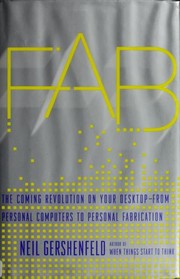Check nearby libraries
Buy this book

"What if you could someday put the manufacturing power of an automobile plant on your desktop? It may sound far-fetched-but then, thirty years ago, the notion of "personal computers" in every home sounded like science fiction. According to Neil Gershenfeld, the renowned MIT scientist and inventor, the next big thing is personal fabrication the ability to design and produce your own products, in your own home, with a machine that combines consumer electronics with industrial tools. Personal fabricators (PF's) are about to revolutionize the world just as personal computers did a generation ago.
Personal fabricators (PF's) are about to revolutionize the world just as personal computers did a generation ago. PF's will bring the programmability of the digital world to the rest of the world, by being able to make almost anything-including new personal fabricators. In FAB, Gershenfeld describes how personal fabrication is possible today, and how it is meeting local needs with locally developed solutions. He and his colleagues have created "fab labs" around the world, which, in his words, can be interpreted to mean "a lab for fabrication, or simply a fabulous laboratory." Using the machines in one of these labs, children in inner-city Boston have made saleable jewelry from scrap material. Villagers in India used their lab to develop devices for monitoring food safety and agricultural engine efficiency. Herders in the Lyngen Alps of northern Norway are developing wireless networks and animal tags so that their data can be as nomadic as their animals. And students at MIT have made everything from a defensive dress that protects its wearer's personal space to an alarm clock that must be wrestled into silence. These experiments are the vanguard of a new science and a new era--an era of "post-digital literacy" in." - book jacket
Check nearby libraries
Buy this book

Previews available in: English
Showing 4 featured editions. View all 4 editions?
| Edition | Availability |
|---|---|
|
1
Fab: The Coming Revolution on Your Desktop-From Personal Computers to Personal Fabrication
2011, ReadHowYouWant.com, Limited
in English
1459610571 9781459610576
|
zzzz
Libraries near you:
WorldCat
|
|
2
Fab: The Coming Revolution on Your Desktop--From Personal Computers to Personal Fabrication
2008, Basic Books
in English
0786722045 9780786722044
|
zzzz
Libraries near you:
WorldCat
|
|
3
Fab: The Coming Revolution on Your Desktop-from Personal Computers to Personal Fabrication
February 5, 2007, Basic Books
in English
0465027466 9780465027460
|
eeee
Libraries near you:
WorldCat
|
|
4
Fab: the coming revolution on your desktop--from personal computers to personal fabrication
2005, Basic Books
Hardcover
in English
0465027458 9780465027453
|
aaaa
Libraries near you:
WorldCat
|
Book Details
Published in
New York
Table of Contents
Edition Notes
Includes index.
Classifications
The Physical Object
ID Numbers
Community Reviews (0)
Feedback?History
- Created April 29, 2008
- 23 revisions
Wikipedia citation
×CloseCopy and paste this code into your Wikipedia page. Need help?
| March 7, 2023 | Edited by MARC Bot | import existing book |
| December 11, 2020 | Edited by MARC Bot | import existing book |
| July 15, 2019 | Edited by MARC Bot | import existing book |
| November 5, 2016 | Edited by Darby | Edited without comment. |
| April 29, 2008 | Created by an anonymous user | Imported from amazon.com record. |













